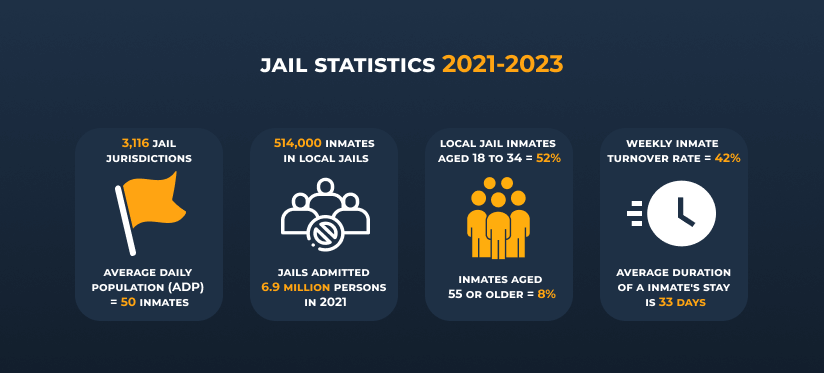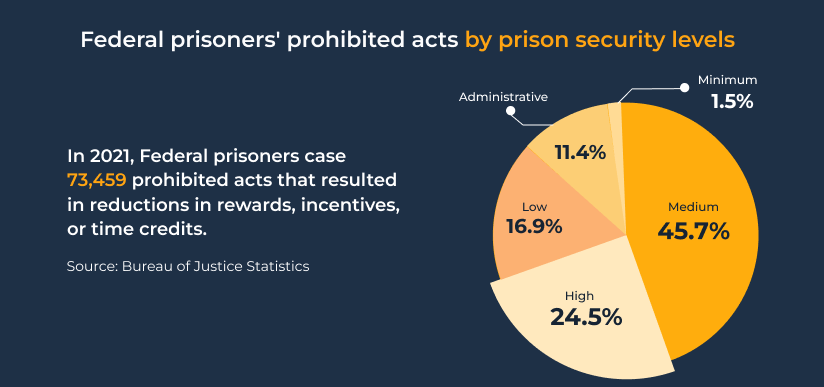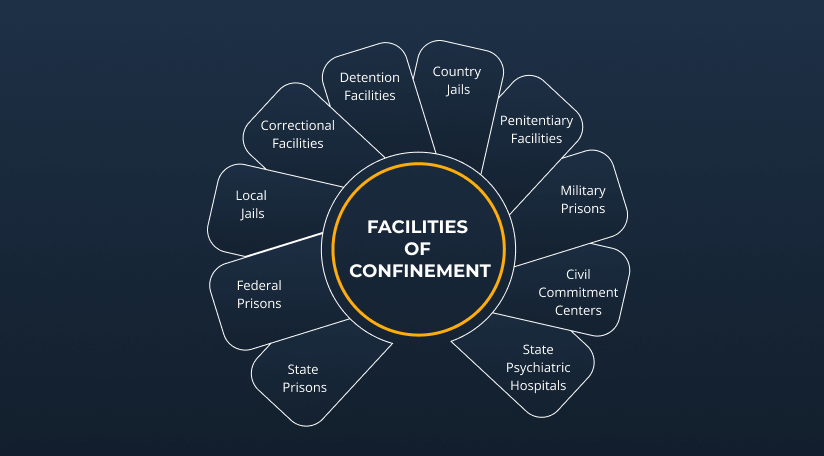
The United States has various systems of confinement, including:
Also, there exist military prisons, civil commitment centers, state psychiatric hospitals, and correctional facilities in U.S. territories. In total, they hold almost 1.9 million people.
So, when it comes to the criminal justice system, prison or jail may seem like synonymous terms. But, they serve different purposes and have distinct characteristics. In this article, we’ll compare prison vs jail in the USA. Let’s start!

In 2021, about 421,000 individuals entered prisons, alongside 7 million admissions to jails.
So, what’s the difference between jail and prison? Jails are for short-term confinement of individuals awaiting trial or serving shorter sentences. Prisons are for long-term confinement of individuals convicted of more serious crimes. The key jail vs prison difference involves the legal status of inmates, the types of offenses, and the duration of confinement. Let’s take a closer look at the similarities and differences between jails and prisons.
Purpose and jail vs prison time
Short-term confinement for pretrial detainees, who cannot pay the bail or bond, and those with shorter sentences (usually <1 year).
Long-term confinement for individuals convicted of more serious crimes (years to life).
Inmates' Legal Status
Houses individuals not yet convicted.
Holds convicted inmates serving sentences.
Types of Offenses
For less serious offenses, including minor misdemeanors.
Prison vs jail houses individuals convicted of more serious crimes, often felonies.
Administration
Administered by local authorities or county governments.
Operated by state or federal agencies.
Security Level
Varying security levels, but less secure than prisons.
Different security levels, from min to max.
This may raise the question, is prison better than jail in terms of security? In general, prisons have more stringent security protocols. But, due to the nature of their inmate population, maximum-security prisons may have a higher risk of violence and safety incidents.
Now, let’s explore the prison vs jail definition of terms and key statistics in more detail.

A jail serves as a facility for individuals in those accused of crimes or convicted of minor offenses. Individuals face confinement either as a form of punishment or while awaiting their trial in jail.
Jail versus prison adapted for short-term detention. They offer a temporary holding ground for individuals involved in the criminal justice system. Those held in jails may encompass:
The difference between prison and jail is evident in their administration. The control of jails takes place at the county or municipal level. They operate as temporary holding facilities, distinct from the long-term focus of prisons.
It’s important to note that not everyone within the confines of a jail has faced a criminal conviction. Some find themselves there due to an inability to post bail and are awaiting their day in court. Some types of lawsuits, such as emotional distress claims, slip and fall settlements, or barefoot driving, do not even involve holding a suspect in a jail cell. If you are facing illegal restraint, contact a wrongful arrest attorney as soon as possible.

A prison confines individuals who have committed crimes as a form of punishment for their offenses. Here’s a concise overview:
Prisons are an integral part of the criminal justice system for deterrence, punishment, and, in some cases, rehabilitation. The primary goal is to maintain order and safety while carrying out the sentences imposed by the legal system.

Read also our article “Is Blackmail Illegal? A Comprehensive Guide to its Legal Implications“
Federal prisons and state prisons are two distinct types of correctional facilities in the United States. Let’s start with the federal level.
In the US, federal prisons classify inmates into five security levels:
Administrative prisons serve specific purposes, such as housing inmates requiring special medical care, protective custody, or those undergoing the intake process.

According to the U.S. Department of Justice, 47% of all persons in federal prison were serving time for a drug offense, while in state prisons:
Let’s uncover the difference between federal and state prisons:
Ownership and Jurisdiction
Operated by the U.S. Department of Justice. Federal prisons house individuals convicted of federal offenses, involving crimes with national implications.
State governments own and operate state prisons, which house individuals convicted of violating state laws. These prisons fall under the jurisdiction of the respective state in which they are.
Types of Offenses
Inmates in federal prisons have committed federal offenses, including drug trafficking, immigration violations, and complex fraud cases.
State prisons house inmates convicted of state-level offenses. These offenses include robbery, assault, burglary, manslaughter, and state drug offenses. State laws and regulations govern the prosecution and sentencing of these crimes.
Sentencing and Parole
Federal sentences rarely involve parole; inmates often serve a significant part of their sentences before potential release.
Some states offer parole programs that allow for early release, determined by state parole boards.
Inmate Population
The Federal Bureau of Prisons (BOP) had approximately 157,919 federal inmates in its custody.
According to the Prison Policy Initiative report in 2023, 1 million individuals occupied 1,566 state prisons.
But, is federal prison better than state? Federal vs state prison may be safer and offer more resources for certain non-violent offenders, while state prisons can vary by conditions and opportunities.

Check also our article “What Proof Do You Need for a Restraining Order? A Quick Guide“
Besides jails and prisons, there are other correctional institutions. Let’s define prison vs jail vs penitentiary, as well as what a correctional facility and a detention center are.

Although “prison” is a general term for facilities used to incarcerate convicted individuals, “penitentiary” is often synonymous. But the difference between prison and penitentiary is a focus on the rehabilitation of big criminals.
A penitentiary is a type of prison, used to describe a category of high-security prisons for significant offenders.
In history, “penitentiary” refers to correction and penance, offering inmates a chance for reflection. Today, it’s sometimes used as an alternative to “prison” but can imply a more serious or long-term correctional facility.
The correctional facility has some nuances based on context:
So, a correctional facility is a broad term that encompasses the types of facilities used for rehabilitation. A prison is a type of correctional facility designed for the long-term confinement of convicted individuals.
A detention center confines individuals who are awaiting trial, immigration processing, or other. Its primary purpose is short-term housing until its legal status changes. Detention centers vary in size and jurisdiction, including federal, state, or local operations. They may house individuals detained but not yet convicted.
Jail is one of the detention centers. The primary purpose of a jail is to hold arrested individuals who awaiting sentencing. It can also house individuals serving short sentences for misdemeanor offenses. Jails are often referred to as “incarceration’s front door”. They are the initial point of confinement for many individuals involved in the criminal justice system.
So, is prison and jail the same thing? No. Both institutions confine individuals within the criminal justice system and tool security measures. But, the main difference between prison vs jail is their purpose and the length of time inmates spend there. Jails are shorter-term for individuals awaiting trial or serving sentences of up to 1 year. While prisons are for those sentenced to longer terms of imprisonment.
If you’re faced with legal imprisonment challenges, reach out to us. Our team helps you find a lawyer who will guide you through the prison vs jail process.
Jails often have tough conditions like overcrowding and limited mental health and social services, leading to tensions among inmates. They also offer fewer educational and rehab programs due to short stays. In contrast, prison vs jail has higher security and offers more educational and rehab opportunities.
But it’s important to note that neither is an ideal environment. Both face challenges with mental health care, overcrowding, and safety. Whether one is worse depends on the individual’s situation and viewpoint.
Yes, in general, prison vs jail tends to be more strict. Prisons have higher levels of security and more robust measures in place to manage inmate populations. While jails still have security measures in place, they are generally not as extensive as those in prisons.
In the United States, individuals do not have the legal option to stay in prison. Once the court has sentenced a person to prison, they must serve their sentence as determined. It is not up to the individual to choose to stay in prison.
Jail sentences are shorter, often measured in days, up to a year. In contrast, prison sentences can span from a year to life imprisonment, depending on the severity of the crime.
Jails operated at various levels of government, including county, city, or municipal jails. A county jail is a type of correctional facility, the management of which takes place by county governments. County jail vs state prison hold people charged with misdemeanors or less serious crimes, like DUI or OVI, often those awaiting trial.
For example, if authorities arrest someone for shoplifting, the county jail holds them until their court hearing. If authorities convict them of armed robbery after a trial, the court sends them to a state prison for a long sentence.










